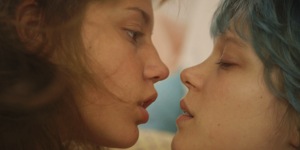
There’s nothing remotely interesting about Blue is the Warmest Color except everything. The three-hour lesbian love story in French that won the Palme d’Or at Cannes this year features all of the oldest tropes of both love stories and queer love stories. We have the same boy meets girl, loses girl, tries to get girl back again plot except in Blue, it’s just with two girls. And like almost every queer love story, coming out is a central theme; girl realizes she’s a lesbian when she falls in love at first sight, she gets called slurs, and she hides her love and her lesbianism. If you’ve seen any queer themed love stories, you’ve seen Blue is the Warmest Color. But you haven’t. Because only once in a decade of blue moons is there a film that does all of these things so effectively, creating such a moving and beautiful experience.
Adele (Adèle Exarchopoulos) is a high school student and a little sexually confused. At her friends urging, she begins dating a sweet, gorgeous boy (Salim Kechiouche) but after they have sex, she retracts from him, because she’s confused about her attraction to women. One night, a gay friend takes her to a gay bar and she meets Emma (Léa Seydoux), a blue-haired college student she had seen on the street one day and had been immediately infatuated with. When Emma picks her up at school, Adele’s friends mercilessly bully her about being a lesbian, which Adele denies being. Despite this, Adele and Emma stay together, fall in love, and have a lot of sex that is filmed explicitly and at length. Eventually, as the years go by, Adele becomes jealous of Emma’s friends and her success, and she becomes tempted by another.
In the hands of an American mainstream director, Blue would have been 90 minutes, maybe 105. But Abdellatif Kecheche’s film is two hours and 59, and this is not because there is so much dialogue or so much action. Kecheche uses lengthy shots, sometimes of scenery or of walking, giggling, eating or mingling at a party to create the mood his actresses are feeling; it is almost impossible not to know and understand and empathize with them. With his slightly washed out, jagged hand-held digital camerawork, Kecheche does not create particularly beautiful images as much as specific and powerful emotions.
However, Kecheche was only able to succeed with these methods because his actresses are so extraordinarily talented. As Adele, Exarchopoulos gives perhaps the most moving, most believable depiction of a confused girl in love. Not since Claire Danes in My So-Called Life have I seen a young actress create such an emotionally resonant performance, and unlike Danes, Exarchopoulos never seems to be acting. She just is experiencing life on screen. Seydoux, as the older, more experienced half of the couple, is less powerfully sympathetic, despite two great scenes. She just doesn’t have the same amount of resonance because she experiences much less strife.
Much has been made about the long and explicit sex scenes. As I felt with the much more explicit scenes in I Want Your Love (about gay men in San Francisco), I didn’t feel they were as needed for character development and plot as their most passionate defenders do. But in both films, they feel and clearly are real, so the authenticity to the sex adds to the authenticity and power of the emotions. And that’s another way how Blue is the Warmest Color is so very different from your typical romance.
MOVIE REVIEW
Blue is the Warmest Color
Directed by Abdellatif Kechiche
Written by Abdellatif Kechiche and Ghalia Lacroix
Starring Adèle Exarchopoulos and Léa Seydoux
Rated NC-17
Opens at Landmark Hillcrest Nov. 8











